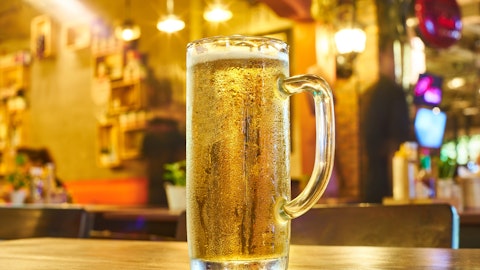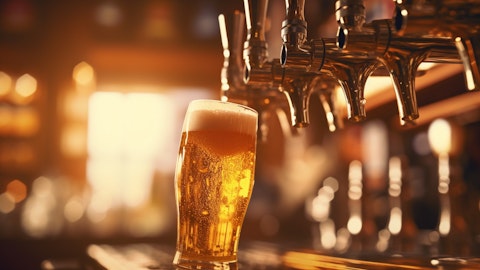We recently compiled a list of the 7 Best Wine Stocks To Buy Now. In this article, we are going to take a look at where The Duckhorn Portolio, Inc. (NYSE:NAPA) stands against the other wine stocks.
Over the last few decades, winemaking has become immensely popular in America as both a business venture and a hobby. When prohibition passed in 1920, the popularity of winemaking plummeted and would stay relatively obscure for half a century. However, the turning point for American wine occurred on May 24, 1976, when some California producers entered their vino in a blind tasting, comparing California wines with French. The judging panel was exclusively French, so it was a shock when Californian wines were ranked the highest in both of the competition categories – Chardonnays and Reds. The results of what became known as the Judgment of Paris were reported in Time Magazine, thus attracting international attention towards premier wines from the Golden State. That year marked the beginning of an American wine renaissance, and today there are over 11,600 wineries in the U.S. that offer an incredibly diverse selection of wines.
READ ALSO: 20 Largest Publicly Traded Liquor Companies in the US
Global Wine Market:
Wine is one of the Most Consumed Alcohols in the World. It is also gaining huge popularity among millennials and youngsters, owing to its refreshing appeal and low ABV offerings. The rising demand for premium and luxury wines, increasing consumer awareness about the health benefits of wine, and the growing popularity of wine tourism are some of the key factors driving the growth of the wine market.
As we mentioned in our article – 15 Biggest Wine Companies in the US – the global wine market size was valued at $441.6 billion in 2022 and is projected to reach a value of $698.54 billion by 2030, with a CAGR of 5.9% over the forecast period.
According to the 2024 BMO Wine Market Report, the actual dollar sales of all wine sold in the U.S. market reached $107 billion in 2023 – an all-time high. Considering that wine dollar sales in the country were just over $73 billion in 2018, the market has witnessed a staggering increase of 46% in the last few years. The report also indicates that the largest U.S. wine companies account for more than 80% of the overall wine production in the country. Here are the U.S. States that Drink the Most Wine.
State of the American Wine Industry:
The American wine industry has always assumed that younger generations would naturally increase their consumption of wine as they grew older, but the truth is that it’s not happening. A report by the Silicon Valley Bank shows how wine hasn’t gained the same traction among those under 60 as it has for baby boomers. Of survey respondents aged 35 to 44, 29% said they were more likely to bring beer to a party, while 28% said they would bring wine. Even younger drinkers, aged 21 to 34, were more likely to bring beer, spirits, a flavored malt beverage, or hard seltzer over wine. But ask a 65-year-old what he or she plans to bring to a party and 49% are likely to grab a bottle of wine.
Winemakers and advertisers are missing out on younger consumers by failing to produce wines that fit their budgets and neglecting to reach out to them with targeted marketing campaigns. The notions of health, sustainability, and responsibility are essential to buying decisions for Gen Z and millennials, and although many wineries are already addressing this, their messaging is only sometimes connecting to these young drinkers. In order to appeal to these whole new demographics of consumers, the wine industry as a whole has to take steps to inspire curiosity and intrigue about wine and to highlight the aspects that would appeal to them.
Trends of Global Wine Consumption:
The global wine consumption in 2023 was estimated to be 221 million hectoliters, marking a decrease of 2.6% compared to the previous year. Since 2018, wine consumed around the world has decreased at a regular rate and 2023 marked the lowest volume recorded since 1996. This negative trend can be mainly attributed to the decline in consumption in China, which has lost an average of 2 million hectoliters per year since 2018. It was further accentuated in 2020 by the Covid-19 pandemic, which negatively affected many large wine markets.
The war in Ukraine and the associated energy crisis, together with the global supply chain disruptions, have led to a spike in costs in production and distribution. This has resulted in significant increases in wine prices for consumers.
Methodology:
To collect data for this article, we scanned Insider Monkey’s database of 912 hedge funds and picked the top 7 companies operating in the wine sector with the highest number of hedge fund investors as of Q2, 2024. When two or more companies had the same number of hedge fund investors, we ranked them by the revenue of their last fiscal year. Following are the Wine Stocks Held by the Most Hedge Funds:
At Insider Monkey we are obsessed with the stocks that hedge funds pile into. The reason is simple: our research has shown that we can outperform the market by imitating the top stock picks of the best hedge funds. Our quarterly newsletter’s strategy selects 14 small-cap and large-cap stocks every quarter and has returned 275% since May 2014, beating its benchmark by 150 percentage points (see more details here).

A picturesque vineyard in North America with wine barrels in storage.
The Duckhorn Portolio, Inc. (NYSE:NAPA)
Number of Hedge Fund Holders: 12
One of the Largest Publicly Traded Liquor Companies in the US, The Duckhorn Portfolio, Inc. (NYSE:NAPA) is a ‘one-stop luxury wine shop’ and the largest pure-play luxury wine company in the U.S. The California-based winemaker posted a revenue of $93.53 million in its Q3 ending April 30th 2024, an increase of 1.4% from the same quarter last year and surpassing analysts’ estimates by 0.37%. This marked the first time that NAPA has surpassed consensus revenue estimates in the last four quarters. On the 30th of April 2024, Duckhorn announced the completion of its acquisition of Sonoma-Cutrer Vineyards, one of the largest and fastest-growing luxury Chardonnay brands in America, from the Brown-Forman Corporation. Moreover, the company is also investing in revamping its distribution network by focusing on wholesale distributors.
However, NAPA’s dependence on luxury wines is proving to be a problem in current times as consumers are watching their wallets. As a result, the company witnessed a volume decline of 4.6% in the last quarter, and now the revamped distribution channel also leaves it vulnerable to a significant channel glut in case of demand slowdown.
Merion Road Capital Management stated the following regarding The Duckhorn Portfolio, Inc. (NYSE:NAPA) in its Q2 2024 investor letter:
“During the quarter I exited our position in The Duckhorn Portfolio, Inc. (NYSE:NAPA) at a loss. Fundamentals came in worse than I expected and I ultimately realized that because the upside was less than my prior expectations, it did not justify current uncertainty.”
Overall NAPA ranks 4th on our list of the best wine stocks to buy. While we acknowledge the potential of NAPA as an investment, our conviction lies in the belief that some AI stocks hold great promise for delivering high returns and doing so within a shorter timeframe. If you are looking for an AI stock that is more promising than NAPA but that trades at less than 5 times its earnings, check out our report about the cheapest AI stock.
READ NEXT: $30 Trillion Opportunity: 15 Best Humanoid Robot Stocks to Buy According to Morgan Stanley and Jim Cramer Says NVIDIA ‘Has Become A Wasteland’.
Disclosure: None. This article is originally published at Insider Monkey.





